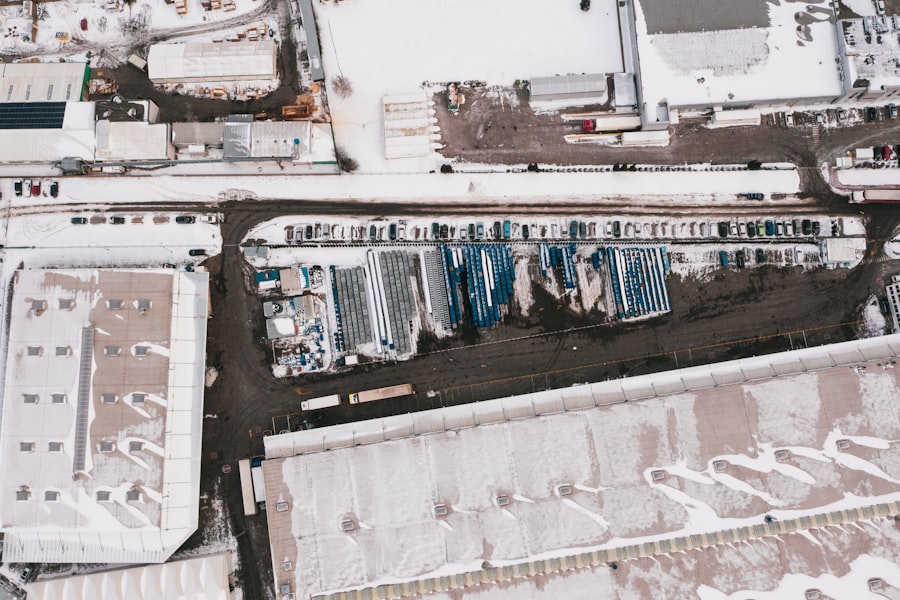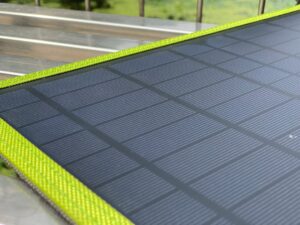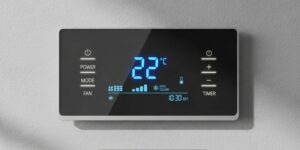Uneven temperature distribution is a phenomenon that affects many homes and commercial buildings, leading to discomfort and inefficiency. This issue arises when certain areas within a space experience significantly different temperatures compared to others. For instance, one room may feel uncomfortably warm while another remains chilly, creating an environment that is less than ideal for occupants.
Understanding the intricacies of uneven temperature distribution is essential for homeowners and business operators alike, as it can impact energy consumption, comfort levels, and overall satisfaction with a living or working space. The implications of uneven temperature distribution extend beyond mere discomfort. It can lead to increased energy bills as heating and cooling systems work harder to compensate for temperature discrepancies.
Additionally, it can affect the longevity of HVAC systems, as they may become overworked and prone to breakdowns. By recognizing the causes and effects of this issue, individuals can take proactive steps to create a more balanced and comfortable environment.
Key Takeaways
- Uneven temperature distribution can lead to discomfort and inefficiency in both homes and commercial buildings.
- Common causes of uneven temperature distribution include poor insulation, air leaks, and inadequate ventilation.
- Effects of uneven temperature distribution can include higher energy bills, discomfort, and potential damage to property.
- Solutions for uneven temperature distribution in homes include sealing air leaks, adding insulation, and using zoning systems.
- Solutions for uneven temperature distribution in commercial buildings include HVAC system upgrades, building automation, and regular maintenance.
Common Causes of Uneven Temperature Distribution
Several factors contribute to uneven temperature distribution within buildings. One of the most prevalent causes is inadequate insulation. Insulation plays a crucial role in maintaining consistent temperatures by preventing heat transfer between the interior and exterior of a building.
When insulation is lacking or improperly installed, certain areas may lose heat more rapidly than others, resulting in cold spots. This is particularly common in older homes where insulation may have deteriorated over time or in newly constructed buildings where building codes may not have been strictly followed. Another significant factor is the design and layout of the space.
Open floor plans may seem appealing, but they can create challenges for effective heating and cooling. Rooms that are far from the HVAC system may not receive adequate airflow, leading to temperature imbalances. Additionally, the placement of furniture and other obstructions can impede airflow, further exacerbating the issue.
Understanding these common causes is the first step toward addressing uneven temperature distribution effectively.
Effects of Uneven Temperature Distribution

The effects of uneven temperature distribution can be far-reaching, impacting both comfort and energy efficiency. For residents, living in a space with fluctuating temperatures can lead to frustration and dissatisfaction. It can disrupt daily activities, making it difficult to find a comfortable spot in the home.
In commercial settings, employee productivity may suffer if workers are unable to maintain a comfortable working environment. This discomfort can lead to decreased morale and increased absenteeism, ultimately affecting the bottom line. From an energy efficiency standpoint, uneven temperature distribution can result in higher utility bills.
When certain areas of a building are too hot or too cold, heating and cooling systems must work overtime to maintain a consistent temperature throughout the space. This excessive strain on HVAC systems not only leads to increased energy consumption but also shortens the lifespan of these systems, resulting in costly repairs or replacements. Addressing uneven temperature distribution is therefore not just a matter of comfort; it is also an essential consideration for energy efficiency and long-term cost savings.
Solutions for Uneven Temperature Distribution in Homes
| Problem | Solution |
|---|---|
| Uneven temperature distribution | Proper insulation installation |
| Sealing air leaks | |
| Installing zoning systems | |
| Regular HVAC maintenance |
Homeowners facing uneven temperature distribution have several solutions at their disposal. One effective approach is to enhance insulation throughout the home. By ensuring that walls, attics, and basements are properly insulated, homeowners can minimize heat loss and create a more consistent indoor climate.
This may involve adding insulation to existing structures or replacing outdated materials with more efficient options. Another solution involves optimizing the HVAC system itself. Homeowners can benefit from regular maintenance checks to ensure that their heating and cooling systems are functioning efficiently.
This includes cleaning or replacing air filters, checking ductwork for leaks, and ensuring that vents are unobstructed. In some cases, homeowners may consider installing zoning systems that allow for different areas of the home to be heated or cooled independently, providing greater control over temperature distribution.
Solutions for Uneven Temperature Distribution in Commercial Buildings
Commercial buildings often face unique challenges when it comes to uneven temperature distribution due to their size and complexity. One effective solution is to conduct a thorough energy audit to identify areas of heat loss or gain. This audit can reveal issues such as poorly insulated walls or roofs, which can then be addressed through targeted improvements.
Additionally, commercial spaces can benefit from advanced HVAC technologies that allow for better control over temperature distribution. Variable refrigerant flow (VRF) systems, for example, enable different zones within a building to be heated or cooled according to specific needs. This flexibility not only enhances comfort but also improves energy efficiency by reducing unnecessary heating or cooling in unoccupied areas.
Importance of Proper Insulation and Ventilation

Proper insulation and ventilation are critical components in achieving even temperature distribution within any building. Insulation acts as a barrier against heat transfer, helping to maintain desired temperatures regardless of external weather conditions. Without adequate insulation, buildings become susceptible to drafts and temperature fluctuations that can lead to discomfort and increased energy costs.
Ventilation plays an equally important role by ensuring that fresh air circulates throughout the space while also allowing for the escape of stale air. Proper ventilation helps regulate humidity levels, which can affect perceived temperature. For instance, high humidity can make a space feel warmer than it actually is, while low humidity can create a chillier environment.
By balancing insulation and ventilation effectively, building occupants can enjoy a more stable and comfortable indoor climate.
Professional Help for Uneven Temperature Distribution
While many homeowners and business operators may attempt to address uneven temperature distribution on their own, seeking professional help can often yield more effective results. HVAC specialists possess the expertise needed to diagnose underlying issues accurately and recommend tailored solutions based on specific building characteristics. They can conduct comprehensive assessments of insulation quality, ductwork integrity, and system performance.
In addition to HVAC professionals, energy auditors can provide valuable insights into how buildings use energy and where improvements can be made. These experts utilize specialized tools to measure airflow, detect leaks, and assess insulation effectiveness. By collaborating with professionals in these fields, individuals can develop a comprehensive strategy for achieving even temperature distribution that enhances comfort while also promoting energy efficiency.
Conclusion and Tips for Maintaining Even Temperature Distribution
In conclusion, uneven temperature distribution is a common issue that affects both residential and commercial spaces, leading to discomfort and increased energy costs. By understanding its causes and effects, individuals can take proactive measures to create a more balanced indoor environment. Solutions such as improving insulation, optimizing HVAC systems, and seeking professional assistance are essential steps toward achieving even temperature distribution.
To maintain consistent temperatures over time, individuals should regularly check insulation quality, ensure proper ventilation, and schedule routine HVAC maintenance. Simple practices like keeping vents clear of obstructions and using ceiling fans strategically can also contribute to improved airflow throughout a space. By implementing these strategies and remaining vigilant about potential issues, occupants can enjoy a comfortable environment year-round while minimizing energy consumption and costs associated with uneven temperature distribution.
If you are looking to improve the temperature distribution in your home while also being environmentally conscious, you may want to consider using sustainable building materials. According to this article, using materials like bamboo, reclaimed wood, and recycled metal can help regulate temperature and reduce energy consumption. By incorporating these materials into your home, you can create a more comfortable living environment while also reducing your carbon footprint.
FAQs
What causes uneven temperature distribution in a space?
Uneven temperature distribution in a space can be caused by factors such as poor insulation, air leaks, inadequate ventilation, and inefficient heating or cooling systems.
How does poor insulation contribute to uneven temperature distribution?
Poor insulation allows heat to escape in the winter and enter in the summer, leading to uneven temperature distribution within a space.
What role do air leaks play in uneven temperature distribution?
Air leaks can allow warm or cool air to escape from a space, leading to uneven temperature distribution. They can also allow outside air to enter, affecting the overall temperature.
How does inadequate ventilation impact temperature distribution?
Inadequate ventilation can lead to pockets of stagnant air, resulting in uneven temperature distribution within a space.
What effect do inefficient heating or cooling systems have on temperature distribution?
Inefficient heating or cooling systems may struggle to maintain a consistent temperature throughout a space, leading to uneven temperature distribution.
How can uneven temperature distribution be addressed?
Uneven temperature distribution can be addressed by improving insulation, sealing air leaks, ensuring proper ventilation, and maintaining efficient heating and cooling systems. Additionally, using fans or adjusting air vents can help to redistribute air and even out the temperature within a space.






